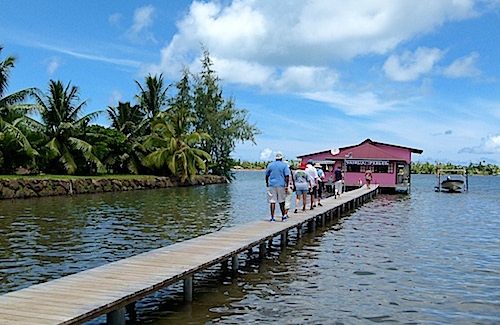Shore Excursion: Learning about black pearls and rare flower that grows only on Raiatea
By Jackie Sheckler Finch
The island of Raiatea is home to a five-petal flower so rare that it grows nowhere else on earth except here. Named Tiare Apetahi, the blossom rising out of a bed of dagger-shaped leaves has an equally lovely legend.
The story goes that a beautiful Tahitian woman named Apetahi fell in love with the son of a king. Devastated that as a commoner she could not marry him, Apetahi fled to Mount Temehani on Raiatea where she died of a broken heart.
Soon after, a flower sprouted from the ground where the lovelorn Tahitian had died. The unusual flower has only five petals, said to be the fingers of Apetahi reaching for her forbidden lover. The soft cracking sound that can be heard as the flower opens each dawn is the sound of her heart breaking. The sacred flower is the island’s emblem.
On today’s shore excursion, we will be visiting a black pearl farm to learn how the pearls are cultivated and we’ll also see the Tainuu Marae open-air temple. Although our group is small, we have a huge air-conditioned bus and a tour guide named Claire.
“Raiatea was considered the birthplace of the gods. It was the heart of Polynesia and the first island colonized by the Polynesians,” Claire said. Raiatea was the starting point for the Polynesians to board their famous double canoes to colonize Hawaii, the Cook Islands and New Zealand.
Known as “the homeland,” Raiatea also is believed to be the final resting place for the spirits of ancestors. “The name means ‘faraway heaven,’” Claire said, adding that the island population today is about 12,000.
Cultivating black pearls
For our first stop at Vairua Perles, we walked down a long dock to watch live oysters being cultivated to create black pearls. Polynesian mythology says that black pearls were the first flickers of light given to humans by the god Ora.
In its natural state, a pearl forms and develops when an irritant gets inside the shell of an oyster. To deal with the intruder, an oyster will cover the irritant with successive layers of nacre, a smooth hard crystalline substance. Layer upon layer of this coating is deposited until a lustrous pearl is formed.
For cultured black pearls, a skilled technician carefully implants an irritant in the oyster rather than leaving it to chance. A guide at the pearl farm demonstrated how live oysters are opened, an incision is made in the oyster’s body, a tiny piece of mantle tissue from another oyster is placed, then a small round shell or nucleus is placed beside the mantle tissue.
“We get the nucleus that we place in the live oyster from freshwater mussel shells that come from the Mississippi River in America,” the guide said. “When we are done with the grafting, we put the oyster back in the sea and wait 18 months for a pearl to develop.”
The grafting operation is a very delicate procedure. Some oysters reject their nucleus or die. Only 25 to 30 oysters out of every 100 will produce commercial pearls. After watching the demonstration, we had time to visit the pearl shop where the prices were said to be reasonable and the quality high.
Tainuu Marae
Next, we headed to the Tainuu Marae open air temple. If it seems like I am writing about a marae in every French Polynesian island we visit, it is because each island does have its own special marae and usually more than one.
This one is known for its size – 162 feet long by 20 feet wide – and stone petroglyphs at the entrance. The stones are so well stacked that they have lasted for centuries without the use of any form of adhesive.
Guide Claire pointed out the turtle motif carved into the stones. “The turtle was considered sacred,” she said. “The only ones who could eat turtle meat were the chiefs and priests.”
Today, the historic marae is also the site of the island’s oldest Protestant church, built with stone blocks taken from the marae. Missionaries considered the marae to be heathen worship places that needed to be destroyed or abandoned as Polynesians converted to Christianity.
“The church was built on the sacred grounds as an attempt by missionaries to bury Polynesian religious sites,” Claire said.
Now the two religious sites exist side by side.
Photo by Jackie Sheckler Finch















View Recent Comments